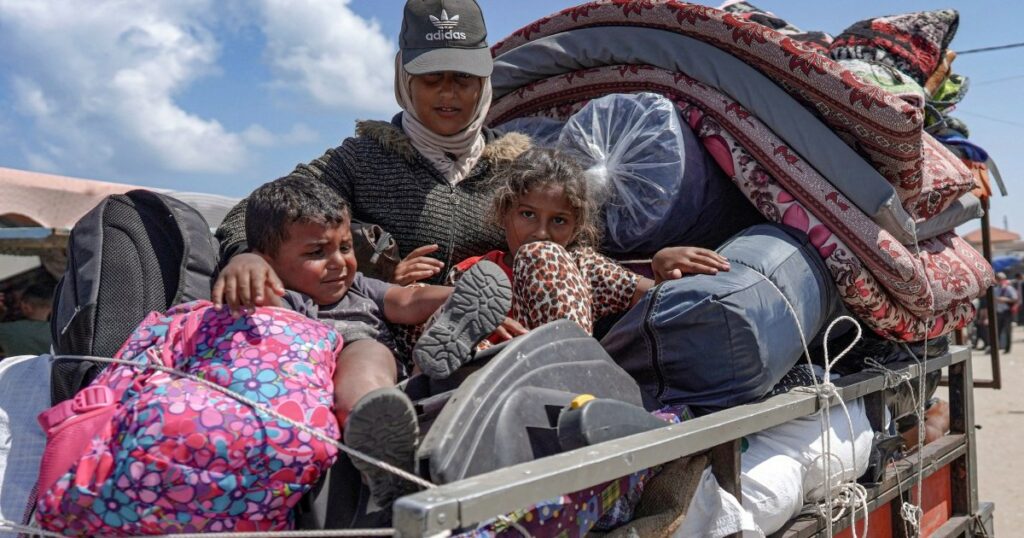The Internal Displacement Monitoring Centre (IDMC) has reported that the number of internally displaced people (IDPs) worldwide reached a record high of 75.9 million in 2023. This increase was driven by 7.7 million people displaced by disasters and 68.3 million by conflict and violence, with conflicts in Sudan and Gaza contributing significantly to the numbers.
According to the report released by the IDMC, conflicts in Sudan and Gaza led to millions of people being forced to flee their homes. IDMC director Alexandra Bilak expressed concern over the rising trend of people being displaced due to conflict and violence, especially in regions where the situation had previously been improving.
The report highlighted that the figure of 75.9 million IDPs in 2023 was a significant increase from the 71.1 million recorded in 2022, representing a more than 50 percent increase over the past five years. Conflict was identified as the main driver of internal displacement, with 22.6 million people displaced by conflict in 2023 alone.
Sudan was singled out as having the highest number of IDPs for a single country since records began in 2008, with an estimated 9.1 million people displaced. Additionally, almost half of all IDPs globally reside in sub-Saharan Africa.
Fighting in Sudan, the Democratic Republic of the Congo, and the Palestinian territory accounted for the majority of new displacements in 2023. In Gaza, 1.7 million Palestinians were internally displaced by the end of the year following a conflict with Israel.
The report also noted that a significant number of people were displaced multiple times within their own countries, with 3.4 million new movements recorded in 2023. Disasters, including severe weather events and earthquakes, also contributed to displacement, with China and Turkey being particularly affected.
The IDMC report emphasized that displacement often leads to long-term challenges due to infrastructure damage and institutional disruption. Despite a reduction in violence, Syria still had 7.2 million internally displaced people in 2023, down from a peak of 7.6 million in 2014.
The Norwegian Refugee Council (NRC) created the IDMC in 1998, with NRC chief Jan Egeland expressing concern over the lack of protection and assistance for millions of displaced individuals. He called for stronger efforts in conflict prevention and peace-making to address the growing crisis of internal displacement worldwide.
#Number #internally #displaced #people #hit #record #Report
Analysis of the Number of Internally Displaced People Report
The report on the record number of internally displaced people in 2023 highlights the dire situation faced by millions around the world due to conflict and disasters. The increase in IDPs by 4.8 million from the previous year is alarming and calls for immediate attention and action.
Long-Term Implications
The long-term implications of such a high number of internally displaced people are profound. Displacement often leads to loss of livelihoods, lack of access to basic services, and mental health issues. The prolonged displacement can also strain resources in host communities and exacerbate social tensions.
Possible Future Developments
If the current trends continue, we can expect to see a further increase in the number of internally displaced people in the coming years. Ongoing conflicts in regions like Sudan and Gaza, as well as the impact of climate change leading to more frequent disasters, will contribute to this trend.
Actionable Advice
1. Increased Humanitarian Aid: The international community must step up efforts to provide humanitarian aid to internally displaced populations. This aid should focus on providing basic necessities such as shelter, food, water, and healthcare.
2. Conflict Prevention and Resolution: Efforts should be made to prevent conflicts and resolve existing ones through diplomatic means. Investing in conflict resolution mechanisms can help prevent the displacement of more people.
3. Sustainable Reintegration: When it is safe to do so, efforts should be made to facilitate the sustainable reintegration of internally displaced people into their communities. This includes rebuilding infrastructure, providing job opportunities, and psychosocial support.
4. Climate Change Adaptation: Given the increasing number of displacements due to disasters, there is a need to prioritize climate change adaptation measures. This includes early warning systems, resilient infrastructure, and community-based disaster preparedness.
By taking proactive measures and addressing the root causes of displacement, we can work towards reducing the number of internally displaced people and ensuring a more stable and secure future for all.
Source: Al Jazeera and news agencies

